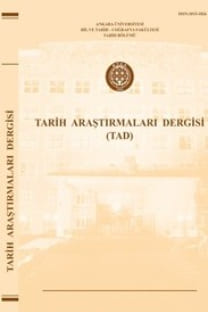Hünkâr İskelesi Antlaşması’nın Osmanlı-İngiliz ilişkilerine yansımaları
1831 yılında isyan eden Kavalalı Mehmet Ali Paşa, ordusunu Kütahya’ya kadar sevk ederek İstanbul’u tehdit etmeye başlamıştı. Oldukça zor durumda kalan Sultan Mahmut, Ruslardan yardım istemek zorunda kalmış, Mısır sorunu çözüldükten sonra Ruslarla Hünkâr İskelesi Antlaşması’nı imzalamıştı. Mısır Valisi’nin başkaldırısına başlangıçta kayıtsız kalan İngiltere, çıkarları açısından büyük bir tehdit olarak gördüğü antlaşmaya şiddetle tepki gösterdi. Bu süreçte Rusların antlaşmaya dayanarak tekrar İstanbul’a asker sevkini önlemek için Osmanlı Devleti’nin Mehmet Ali Paşa ile yeniden savaşa girmesini engellemeye çalıştı. Aynı zamanda Osmanlı Devleti’nin güçlenmesi için Babıâli’ye her türlü desteği verdi. Böylece bu tarihten itibaren Osmanlı Devleti’ni korumak İngiltere’nin devlet politikası haline geldi
Anahtar Kelimeler:
Hünkâr İskelesi, Mehmet Ali Paşa, Butenef, Ponsonby, Palmerston
The Reflections of the Hunkar Iskelesi Treaty on the Ottoman-British Relations
Kavalalı Mehmet Ali Paşa, who revolted in 1831, marched his army as far as Kütahya and started to threaten Istanbul. Sultan Mahmut, who was in a grave situation, had to ask for Russian help and signed the Hünkâr İskelesi Treaty with the Russians after the Egyptian problem was resolved. Although England remained indifferent to the rebellion of the Governor of Egypt at first place, she reacted severely to the treaty, which she saw as a threat to her interests. During this process, she tried to stop the Ottoman State from going to war against Mehmet Ali Pasha again, in order to stop the Russians from sending military forces to Istanbul on the grounds of the treaty. In the meantime, she supported the Sublime Porte in
Keywords:
Hunkar Iskelesi, Mehmet Ali Pasha, Butenef, Ponsonby, Palmerston,
___
- Hatt-ı Hümayûn (HAT) 360/20057, 360/20065-C, 360/20065-D, 361/20096-B , 367/20178/A, 367/20253, 367/20308, 369/20346, 377/20483, 383/20609, 383/20609-B, 383/20609-C, 451/22362, 909/ 39798-A, 948/40772, 1040/43061, 1040/43061-B, 1044/43171, 1045/43183-A , 1045/43186, 1047/43218, 1124/ 44969, 1166/46123-A, 1166/46123-B, 1166/46126, 1167/46155-A, 1168/46195-A, 1168/46201, 1168/46207-A, 1169/46234-A, 1169/46234-B, 1170/46289, 1172/46380, 1174/46430-M, 1178/46558, 1293/50230-A, 1343/52488-F.
- The National Archive (NA), Foreing Office Papers (FO)78/237, 78/238, 78/239,78/240, 78/243, 78/244, 78/245.
- Ahmed Lütfi Efendi, Vakanüvîs Ahmed Lûtfî Efendi Tarihi, Tarih Vakfı-Yapı Kredi Yayınları, IV-V, İstanbul 1999.
- Ali Fuat, “Mısır Valisi Mehmet Ali Paşa”, Türk Tarih Encümeni Mecmuası, Numero 19(96), İstanbul Devlet Matbaası, 1928, s.64-121.
- ANICK, Norman, The Embassy of Lord Ponsonby to Constantinople 1833-1841, (Ph.D, McGill University), Montreal 1970.
- ARMAOĞLU, Fahir, 19. Yüzyıl Siyasî Tarihi (1789-1914), TTK, Ankara 1997.
- BAKER, R.L., “Palmerston on the Treaty of Unkiar Skelessi”, The English Historical Review, Vol 43, No. 169 (Jan.1928), pp.83-89.
- BOLSOVER, G.H., “Lord Ponsonby andthe Eastern Question (1833-1839)”, The Slavonic and East European Review, Vol.13, No.37 (jul 1934), s.98-118.
- CAMERON,D.A., Egypt in the Nineteenth Century or Mehemet Ali and His Successors Until The British Occupation in 1882,London 1895.
- KUTLUOĞLU, Muhammed H., The Egyptian Question(1831-1841), Eren Yayıncılık, İstanbul 1998.
- Muâhedât Mecmûası,I, IV, TTK, Ankara, 2008.
- RODKEY, Frederick Stanley, “Lord Palmerston and the Rejuvenation of Turkey 1830- 1841”, The Journal of Modern History, Vol.1, No.4 (Dec.1929), s.627-640.
- RUSTUM, Asad Jiprail, “Syria Under Mehemet Ali”, The American Journal of Semitic Languages and Literatures, Vol 41, No.1 (october 1924), s.34.57.
- Saffet, “Mısır Meselesine Dair”, Türk Tarihi Encümeni Mecmuası, 1 Temmuz 1926 Numero 16(93), s.224-249.
- SINOUÈ Gilbert, Kavalalı Mehmet Ali Paşa Son Firavun, (Çev. Ali Cevat Akkoyunlu), Doğan Kitap, İstanbul 1999.
- SOY, Bayram, “Lord Palmerston’un Osmanlı Toprak Bütünlüğünü Koruma Siyaseti”, Hacettepe Üniversitesi Türkiyat Araştırmaları Enstitüsü, Sayı:7, Güz 2007, s.141-167. 4- Gazeteler Takvim-i Vekayi
- ISSN: 1015-1826
- Yayın Aralığı: Yılda 2 Sayı
- Başlangıç: 1963
- Yayıncı: Levent KAYAPINAR
Sayıdaki Diğer Makaleler
The ancient population of a Chersonessian Heir: Phoinix
Smyrna'yı M.S. 177 Yılı Depreminden Kurtaran Aelius Aristeides'in 18. 19. ve 20. Söylevleri
15-16. yüzyıl göçlerinin Osmanlı iskân yapısına etkisi
Hünkâr İskelesi Antlaşması’nın Osmanlı-İngiliz ilişkilerine yansımaları
Smyrna’yı M.S. 177 yılı depreminden kurtaran Aelius Aristeides’in 18. 19. ve 20. söylevleri
Kafkasya’ya (1916-1917) Osmanlı istihbaratının yayımladığı bir rapor
Haçlıların, Askalân şehrini zaptı
